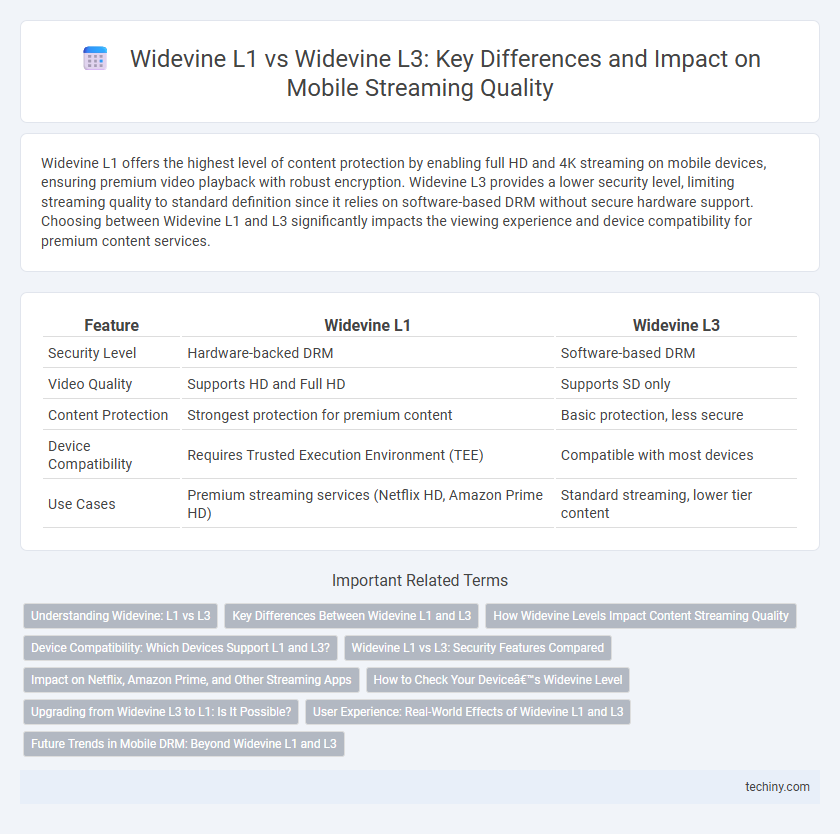Widevine L1 offers the highest level of content protection by enabling full HD and 4K streaming on mobile devices, ensuring premium video playback with robust encryption. Widevine L3 provides a lower security level, limiting streaming quality to standard definition since it relies on software-based DRM without secure hardware support. Choosing between Widevine L1 and L3 significantly impacts the viewing experience and device compatibility for premium content services.
Table of Comparison
| Feature | Widevine L1 | Widevine L3 |
|---|---|---|
| Security Level | Hardware-backed DRM | Software-based DRM |
| Video Quality | Supports HD and Full HD | Supports SD only |
| Content Protection | Strongest protection for premium content | Basic protection, less secure |
| Device Compatibility | Requires Trusted Execution Environment (TEE) | Compatible with most devices |
| Use Cases | Premium streaming services (Netflix HD, Amazon Prime HD) | Standard streaming, lower tier content |
Understanding Widevine: L1 vs L3
Widevine L1 provides the highest level of digital rights management (DRM) security by requiring hardware-backed secure video path and cryptographic operations, enabling streaming of high-definition (HD) and ultra-high-definition (UHD) content on compatible mobile devices. Widevine L3 relies solely on software-based DRM, offering lower security and restricting playback to standard definition (SD) streams, often used on devices lacking hardware security modules. Understanding the distinctions between Widevine L1 and L3 is essential for developers and content providers aiming to deliver optimized streaming experiences and comply with content protection requirements.
Key Differences Between Widevine L1 and L3
Widevine L1 provides the highest level of content protection by requiring hardware-backed secure video path and Trusted Execution Environment (TEE), enabling HD and UHD streaming on supported devices. In contrast, Widevine L3 operates entirely in software without hardware protection, restricting playback quality to standard definition (SD) due to weaker security. The key difference lies in the security level and content resolution support, with L1 targeting premium content delivery and L3 suitable for lower-risk, lower-quality streams.
How Widevine Levels Impact Content Streaming Quality
Widevine L1 enables streaming of high-definition content by enforcing strict hardware-based DRM, ensuring premium video quality on compatible devices. Widevine L3 operates purely in software, limiting streaming to standard definition and restricting access to higher resolution content. The level of Widevine significantly impacts user experience by determining available streaming quality and content protection robustness.
Device Compatibility: Which Devices Support L1 and L3?
Widevine L1 is supported primarily on high-end Android devices with hardware-backed DRM capabilities, enabling full HD and 4K streaming on platforms like Netflix and Amazon Prime Video. Widevine L3 is compatible with a wider range of devices, including lower-end smartphones, tablets, and some smart TVs, but restricts playback to standard definition due to its software-only DRM approach. Leading manufacturers such as Samsung, Google Pixel, and OnePlus commonly implement Widevine L1, whereas budget devices often rely on Widevine L3 for content protection.
Widevine L1 vs L3: Security Features Compared
Widevine L1 offers the highest security level by enforcing hardware-backed DRM and trusted execution environments (TEE) to protect content, while Widevine L3 relies solely on software-based security, making it more vulnerable to breaches. L1 supports HD and 4K streaming due to robust encryption and tamper-resistant mechanisms, whereas L3 limits playback quality to SD levels because of its less secure environment. The critical difference lies in Widevine L1's integration with device secure hardware, providing enhanced content protection for premium streaming services compared to the purely software-based Widevine L3.
Impact on Netflix, Amazon Prime, and Other Streaming Apps
Widevine L1 enables HD and 4K content playback on Netflix, Amazon Prime, and other streaming apps by providing the highest level of DRM security through hardware-backed encryption. In contrast, Widevine L3 restricts streaming quality to SD due to software-based DRM, limiting user experience on devices without Trusted Execution Environment (TEE). Streaming platforms rely on Widevine L1 certification to deliver premium content securely, influencing device compatibility and video quality.
How to Check Your Device’s Widevine Level
To check your device's Widevine level, use apps like DRM Info available on Android, which display detailed DRM certifications including Widevine L1 or L3 status. Widevine L1 ensures hardware-level secure video playback for HD and UHD streaming, while Widevine L3 relies on software-based security, limiting quality to standard definition. Verifying the Widevine level helps users confirm their device's capability to stream premium content from platforms like Netflix and Amazon Prime Video.
Upgrading from Widevine L3 to L1: Is It Possible?
Upgrading from Widevine L3 to L1 is generally not possible through software or user intervention because Widevine L1 requires hardware-backed security features that are built into the device's Trusted Execution Environment (TEE). Devices certified only for Widevine L3 lack this hardware support, meaning the upgrade necessitates new hardware rather than a firmware or software update. Content providers rely on Widevine L1 for premium content protection, so device manufacturers must implement TEE-compatible chips during manufacturing to support this level.
User Experience: Real-World Effects of Widevine L1 and L3
Widevine L1 provides enhanced user experience by enabling HD and 4K streaming quality with robust DRM protection on supported devices, ensuring smooth playback and superior video clarity. Widevine L3, typically restricted to SD streaming, offers lower security levels resulting in compromised resolution and potential buffering on high-demand platforms. Users benefit from Widevine L1's seamless integration in premium streaming apps, leading to consistent performance and reduced playback interruptions compared to Widevine L3's limitations.
Future Trends in Mobile DRM: Beyond Widevine L1 and L3
Future trends in mobile DRM indicate a shift towards more adaptive and multi-layered security frameworks beyond Widevine L1 and L3, incorporating AI-driven encryption and biometric authentication for enhanced content protection. Emerging standards like MPEG-CENC with hardware-rooted trust zones aim to reduce reliance on single-level DRM architectures while improving interoperability across devices. Advances in cloud-based DRM solutions and edge computing integration promise lower latency and real-time threat detection, shaping the evolution of digital rights management in mobile ecosystems.
Widevine L1 vs Widevine L3 Infographic

 techiny.com
techiny.com